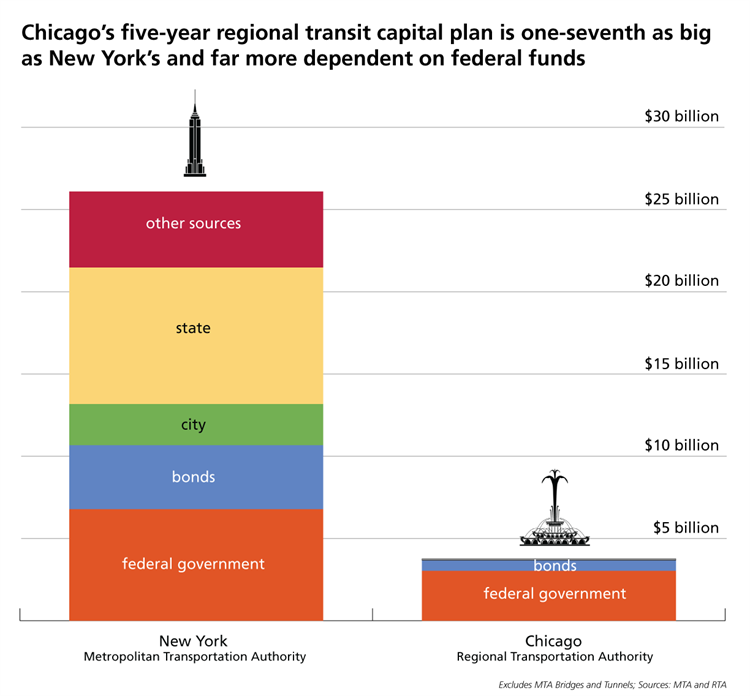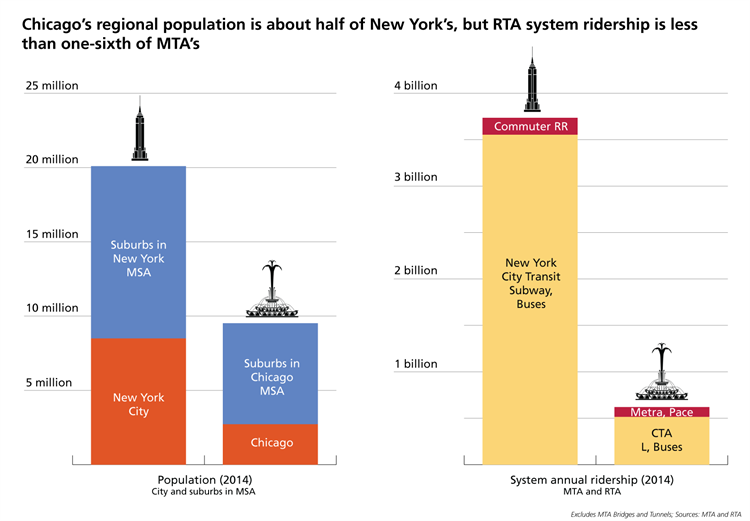After months of discussion, New York Governor Andrew Cuomo and New York City Mayor Bill DeBlasio agreed on a new five-year capital plan for the Metropolitan Transportation Authority, which runs New York’s Subway, buses and two of its commuter rail systems. The capital plan is a huge proposition: $26.1 billion in new expenditures on public transportation in the New York region between 2015 and 2019.
In 1980, the average Chicagoan took transit as many times a year as the average New Yorker. Today, New Yorkers ride transit 60 percent more than Chicagoans.
New York’s capital plan is demonstrative of the effort it takes to invest in aging transit systems in America’s largest cities. As I describe below, its size and scope far exceed investments planned for Chicagoland—mostly because of inadequate state and local support for transit capital in Illinois. The consequence has been less effective transit service and less ridership.
The New York agreement required commitment of $8.3 billion from the state and $2.5 billion from the city. The remainder of the funding package will be covered by bonds to be paid back through fare revenues, federal government grants and other sources.
To be fair, plenty of questions remain about the sources New York State and New York City will use to fund their shares. But New York is in a far stronger condition than Illinois in terms of its ability to release bonds, with a bond rating that is AA+ with a stable outlook, versus Illinois’ BBB+, with a negative outlook (both from Fitch Ratings); New York City’s bond rating is AA with a stable outlook, versus Chicago’s BBB+, with a negative outlook (both from S&P). Illinois’ and Chicago’s poor bond ratings play a big role in our region’s ability to fund its future because of higher interest rates that must be paid back over time.
The New York proposal will include funding for significant new projects, including a new commuter rail line from the Bronx to Penn Station; the beginning of construction on the extension of the 2nd Avenue Subway from 96th Street to 125th Street on Manhattan’s Upper East Side; more than 1,000 new train cars for the Subway and commuter railroads, plus more than 1,400 buses; and significant maintenance upgrades throughout the system. In other words, it’s a lot of new investment.
The plan will generate expansive improvements for the transit system in America’s largest region. A comparison with the five-year capital plan from Chicago’s Regional Transportation Authority, which oversees the Chicago Transit Authority, Metra commuter railroad and Pace suburban buses, is particularly indicative, as the following graph shows.
Not only is the New York plan almost seven times larger—$26.1 billion versus $3.8 billion—but it relies far more on non-federal sources than Chicago’s. Indeed, the amount of money New York City’s Metropolitan Transportation Authority expects to receive from Washington is about twice as large as what Chicago’s Regional Transportation Authority expects ($6.8 billion versus $3 billion)—but while federal funding accounts for just 26 percent of New York’s overall capital plan, it accounts for 80 percent of Chicago’s.
Chicago is actually losing out on additional federal funding it could receive if it had more local and state funding as a match. For example, New York expects to receive hundreds of millions of dollars under the federal New Starts program for new transit lines. Unless Chicago identifies its own local funds for the Red and Purple Line Modernization project—such as through MPC’s proposed Transit Facility Improvement Area—it will not be able to take advantage of that federal program’s funding.

In terms of population, the Chicago region is about half as large as the New York region, as the following graph documents—this explains the rough ratio of distribution of federal dollars.
But New York’s local and state commitment to transit infrastructure is many times larger than Chicago’s, and one result is that ridership on the Metropolitan Transportation Authority system is six times as large as that on the Regional Transportation Authority system.

New York, it seems, is simply more of a “transit city” than Chicago, so perhaps it makes sense that their transportation authority has a much larger capital plan.
But the strong use of transit in New York is not an accident; It is the result of decades of significant investment in that city’s system by state and local governments—investment that continues with the most recent capital plan.
Indeed, Chicago once was by some measures just as much of a “transit city” as New York. In 1980, the average resident of both cities rode local buses or trains 232 times a year (just taking into account New York City Transit and Chicago Transit Authority ridership, and comparing it to city, not regional, population).
Over the past 35 years, however, that similarity has evaporated, as the following graph shows. Now the average New York City resident takes a Subway or local bus 300 times a year, whereas the average Chicagoan rides an ‘L’ train or local bus just 189 times a year.

Investments matter. As the Metropolitan Planning Council’s (MPC) analysis of existing conditions of transit in Northeastern Illinois documented in 2013, public transportation in Chicagoland is seriously underfunded, and the situation is getting worse, both in terms of money for operations and in terms of money for capital improvements.
The lack of adequate funding in the Chicago region is not the fault of the Regional Transportation Authority but rather a reflection of inadequate support from state and local governments. MPC’s Accelerate Illinois campaign is working to identify significant new funding for transportation projects in our state. Without this commitment, our transit system will fall further and further behind.